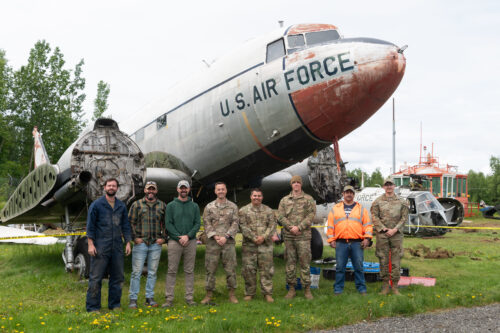A C-47A Skytrain aircraft, known as “Francis L”, recently made a 3,500-mile journey from a museum in Alaska to the Museum of Aviation at Robins Air Force Base, Georgia, where it will undergo a full restoration. The aircraft, which participated in key World War II operations, including D-Day and Operation Market Garden, will be restored to its original condition and put on display.

U.S. Air Force photo by Airman 1st Class Raina Dale
The journey involved a complex operation involving teams from Dover AFB, Delaware, Joint Base Elmendorf-Richardson, Alaska, and Robins AFB. The 402nd Expeditionary Depot Maintenance Squadron from Robins AFB disassembled the aircraft in Wasilla, Alaska, and transported it to JBER. From there, a C-5 aircraft from Dover AFB carried the aircraft to Robins AFB.
Before the C-47 could be loaded onto the C-5 aircraft, it had to be partially disassembled and transported by truck from its location at the Museum of Alaska Transportation and Industry in Wasilla to Joint Base Elmendorf-Richardson (JBER). A team from the 402nd Expeditionary Depot Maintenance Squadron (EDMX) at Robins AFB travelled to Alaska to take on the challenging task of preparing the aircraft for the move. They faced difficulties due to the lack of appropriate support equipment like cranes and maintenance stands at the remote location.
Tech. Sgt. Teodoro Morales, a 402nd EDMS depot craftsman, explained: “Some of the difficulties we faced in Alaska were not having the appropriate support equipment, such as cranes or maintenance stands. Also, the field conditions and the austere location were more challenges that we had to overcome, which made it difficult for us to maneuver our support equipment, as well as the actual aircraft.” The team’s expertise in crash damaged or disabled aircraft recovery was crucial in overcoming these obstacles. The EDMX team, with help from the 773rd Logistics Readiness Squadron at JBER, meticulously broke down “Francis L” for transport, a process that Tech. Sgt. Morales said took four months of planning. This included coordinating with trucking companies that could accommodate the oversized load.
Once at JBER, the 732nd Air Mobility Squadron helped prepare the aircraft for its journey on a C-5M Super Galaxy cargo aircraft from the 512th Airlift Wing at Dover AFB, Delaware. Capt. Nick Schiavone, a pilot from the 709th Airlift Squadron at Dover AFB and flight commander for the mission, shared his thoughts on transporting “Francis L”: “This has been a fantastic opportunity to participate in the movement of this particular C-47. When I found out about this aircraft and its participation in the Normandy landings, it became an honor to preserve a piece of history.” He added: “In addition, the timing of our flight lined up with the anniversary of D-Day made it an extra special occasion for me and the crew of the 709th AS. I can think of no better way to remember the sacrifice our predecessors gave for us to enjoy the freedoms we have today. My hope is that the surviving aircraft will provide the same feeling of honor I feel to those who get to enjoy viewing it at the Museum of Aviation at Robins AFB.”
Upon arrival at Robins AFB, the 78th Logistics Readiness Squadron and Museum of Aviation staff worked together to unload the aircraft from the C-5. Despite a weather delay, the teams efficiently moved “Francis L”‘s components to storage or to areas where restoration would begin
The C-47, tail number 43-15200, has a remarkable history. Delivered to the U.S. Army Air Forces in February 1944, it was assigned to the 9th Air Force in England as part of the 441st Troop Carrier Group. The aircraft flew numerous exercises, including some with the 101st Airborne Division.
During World War II, “Francis L” played a vital role in major operations. It carried men from the 82nd and 101st Airborne Divisions during Operation Overlord, sustaining battle damage while dropping paratroopers in Normandy. It also resupplied American forces during the Siege of Bastogne. Research indicates that it likely participated in Operation Market Garden and Operation Varsity as well.
After the war, “Francis L” was assigned to various units across the country before being placed in storage in 1947. It returned to service in 1949, flying for units in New York, including the 114th Fighter Interceptor Squadron of the New York Air National Guard. In 1957, it was transferred to the 144th Air Transport Squadron of the Alaska Air National Guard. In 1961, it was officially retired from the U.S. Air Force inventory and loaned to the Museum of Alaska Transportation and Industry.
The restoration of “Francis L” at the Museum of Aviation is expected to take a few years. The museum team aims for historical accuracy, addressing challenges like corrosion and scarcity of parts. They also hope to identify the paratroopers the aircraft dropped during Operation Overlord, adding a personal element to the aircraft’s history.
For more information, hit the Source below